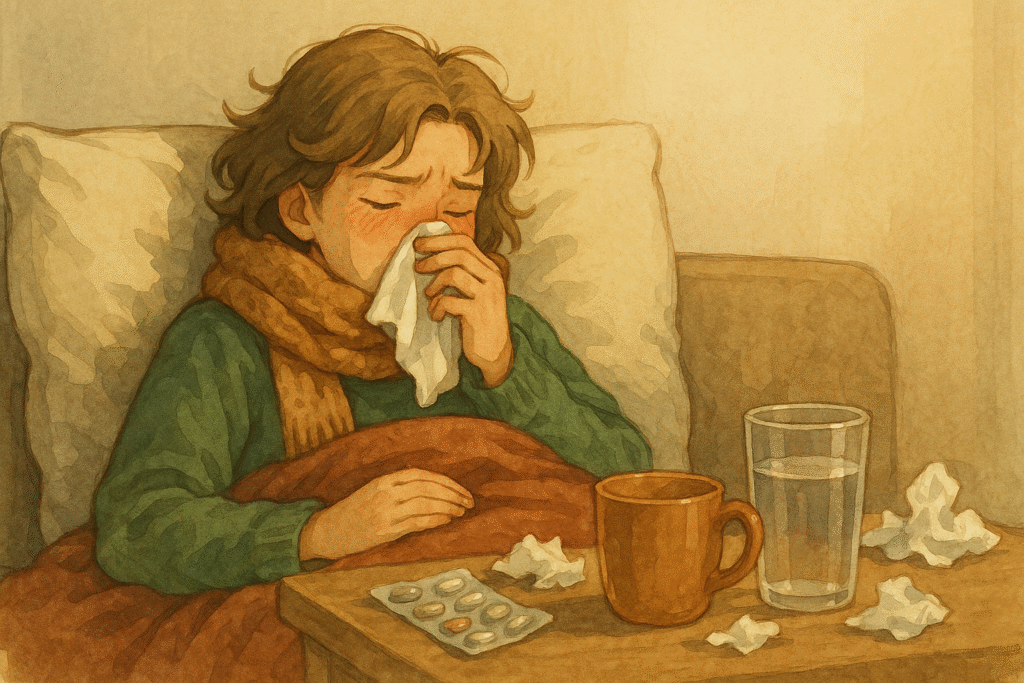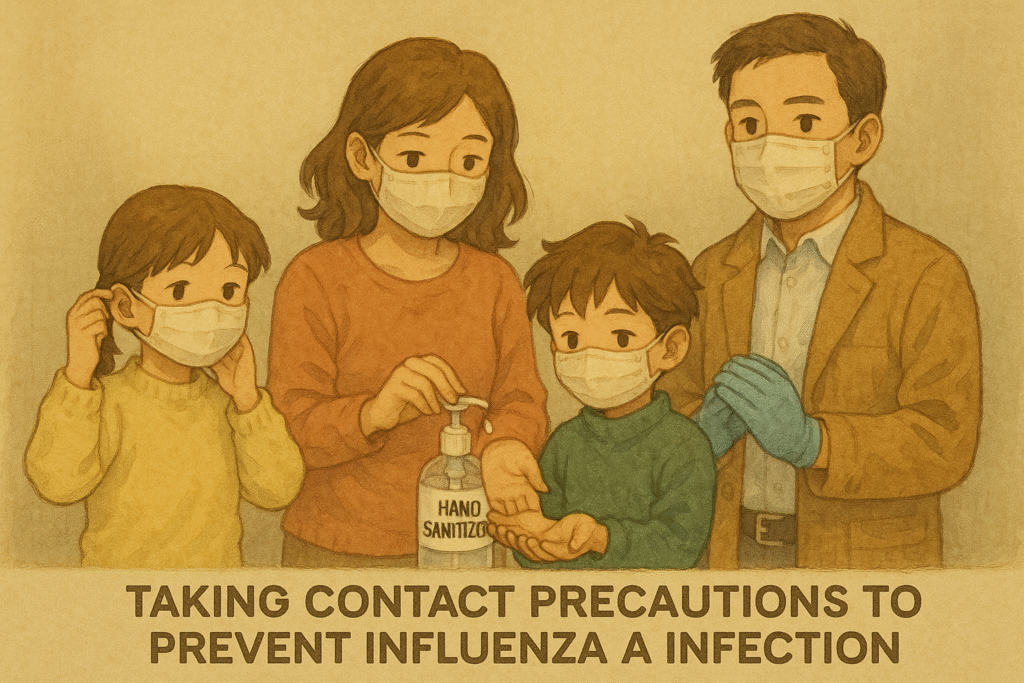Why I’m Writing About Influenza A — Now
In October 2025, Malaysia witnessed a sharp surge in influenza A cases, with thousands of schoolchildren reportedly infected nationwide, prompting temporary school closures and heightened public concern.
According to the Ministry of Health (MOH), there were 97 influenza clusters recorded in epidemiological week 40 — a dramatic increase from just 14 the week before. The majority occurred in schools and kindergartens, especially in Selangor, Kuala Lumpur, Penang, Johor, and Kedah. Health officials confirm that the dominant circulating strain is Influenza A (H3 subtype) — a seasonal variant, not a new mutation.
As an ENT (Ear, Nose & Throat) doctor, I’ve seen a parallel rise in patients with post-flu complications: sinus blockage, sore throats, ear infections, and even voice changes. This prompted me to write about what influenza A is, what to expect, and how we can all play a part in curbing its spread.
Understanding Influenza A

Influenza A is a highly contagious respiratory virus that affects the nose, throat, and lungs. It spreads mainly through droplets when an infected person talks, coughs, or sneezes, and through contaminated surfaces.
Unlike the common cold, influenza A usually strikes suddenly and causes more severe fatigue, fever, and body aches. In tropical climates such as Malaysia, influenza circulates year-round, but surges during the rainy and cooler seasons.
Why Is Influenza A More Dangerous Than Many Other Viruses?
You might wonder: many respiratory viruses circulate every year, so what makes influenza A stand out?
- Deeper and systemic reach — While many viruses stay confined to the nose or throat, influenza A often penetrates into the lungs, triggering viral pneumonia and systemic inflammation.
- Inflammatory damage — The immune response can overshoot, causing lung injury, vascular leak, and even effects on other organs.
- Worsening of chronic illness — People with heart disease, lung disease, kidney disease or diabetes may decompensate when hit by influenza A.
- Greater mortality in pneumonia form — If it evolves to pneumonia, influenza A tends to produce worse outcomes than many non-influenza viral pneumonias.
- Capability for sudden antigenic leaps — Influenza A can undergo antigenic shift, creating new subtypes against which the population has little immunity, raising the risk of severe epidemics or pandemics.
- Time sensitivity for therapy — Delays in antiviral treatment lead to worse prognosis more so than in many mild viral illnesses.
Why ENT Doctors See So Many Influenza A Cases

Because the virus primarily infects the upper airways, ENT specialists frequently see its complications:
- Severe sore throat (pharyngitis / tonsillitis)
- Sinus congestion or pressure (sinusitis)
- Ear infections (otitis media) due to blocked Eustachian tubes
- Hoarseness or laryngitis
- Worsening snoring or sleep apnea during infection
These are the reasons many patients eventually need specialized ENT assessment — often when a “simple flu” doesn’t improve as expected.
Common Symptoms
Typical onset is 1–4 days after exposure, with symptoms appearing abruptly:
- High fever and chills
- Fatigue, headache, and body aches
- Sore throat and dry cough
- Blocked or runny nose
- Muscle pain and general weakness
- In children: irritability, ear pain, vomiting, or refusal to eat
What to Expect During a Doctor’s Visit
Your doctor may:
- Perform a thorough ENT examination.
- Order a rapid influenza or PCR test to confirm infection.
- Start antiviral therapy (e.g., oseltamivir) if within 48 hours of onset.
- Prescribe symptomatic relief — saline rinses, nasal sprays, pain relievers.
- Treat secondary infections (e.g., bacterial sinusitis or ear infection) if present.
ENT evaluation may include nasal endoscopy or ear microscopy for persistent cases.
Course of Illness and Recovery
Most people recover in 5–7 days, though cough and fatigue may linger.
Supportive care — rest, hydration, warm fluids, and proper nutrition — accelerates recovery.
Children, seniors, and those with chronic illnesses require closer monitoring.
What If I Already Have Influenza A?
Practical Steps to Ease Symptoms and Recover Faster

If you’ve tested positive for Influenza A, or your doctor has diagnosed you based on symptoms, don’t panic. Most people recover within a week — but how you care for yourself during this time makes a big difference in comfort, recovery speed, and risk of complications.
Here’s what you can do:
1. Rest and Hydrate Generously
Your body needs energy to fight the virus.
- Rest as much as possible — sleep boosts immune response and shortens illness duration.
- Stay hydrated with water, soups, or electrolyte drinks. Fever and rapid breathing cause fluid loss, which can worsen fatigue and headaches.
2. Manage Fever and Pain Wisely
Use paracetamol or ibuprofen as advised to control fever, body aches, and sore throat. Avoid over-the-counter combination cold medicines unless approved by your doctor — they may worsen dehydration or cause drowsiness.
3. Use Nasal and Throat Relief Measures
- Saline nasal sprays or rinses can clear mucus and ease congestion.
- Steam inhalation (with caution) or a warm shower may relieve sinus pressure.
- Saltwater gargles soothe an irritated throat.
4. Eat Light but Nutritious Foods
Even if your appetite is low, try small, nutrient-rich meals — soups, fruits, and whole grains. Vitamin-rich foods (especially vitamin C, zinc, and protein) aid immune recovery.
5. Take Antivirals Promptly (If Prescribed)
If prescribed oseltamivir (Tamiflu) or other antivirals, start within 48 hours of symptom onset for maximum benefit. Evidence shows early treatment reduces symptom severity and complications.
6. Avoid Antibiotics Unless Indicated
Antibiotics do not kill viruses. They’re only prescribed if you develop secondary bacterial infections (like sinusitis, ear infection, or pneumonia). Misuse contributes to antibiotic resistance.
7. Isolate and Prevent Spread
Stay home until fever-free for at least 24 hours without medication. Wear a mask and avoid close contact, especially with the elderly or children. Clean high-touch surfaces daily.
Support Recovery Even After Symptoms Improve
Continue light activity, adequate hydration, and balanced nutrition even after your fever settles. Post-viral fatigue may linger — listen to your body and resume work or school gradually.
Warning Signs: When to Seek Urgent Medical Care

See a doctor promptly if you experience:
- Persistent fever above 39 °C
- Shortness of breath or chest pain
- Ear pain, fluid, or hearing loss
- Confusion, drowsiness, or fainting
- Thick yellow/green phlegm or worsening cough
- Dehydration (dry lips, little urine, dizziness)
These may signal bacterial infection, pneumonia, or other complications.
🧍♀️🧍♂️ How We Can All Help Prevent the Spread of Influenza A

The current outbreak reminds us that prevention is a collective responsibility. Each small action helps protect vulnerable groups — children, the elderly, and those with chronic disease.
Here’s what everyone can do:
1. Keep Sick Children at Home
Even mild flu symptoms can spread quickly in classrooms. Schools should encourage parents to let unwell students rest until fever-free for 24 hours without medication.
2. Improve Indoor Ventilation
Classrooms, offices, and clinics should open windows or use HEPA filters. Fresh airflow dilutes airborne viruses.
3. Promote Respiratory Etiquette
Teach children (and adults!) to cover coughs/sneezes with elbows or tissues, and dispose of tissues properly.
4. Regular Cleaning of Shared Surfaces
Desks, doorknobs, keyboards, and phones should be wiped frequently — especially in schools and public spaces.
5. Vaccinate Early in the Season
Flu vaccination doesn’t just protect the recipient — it reduces community transmission. Encourage vaccination drives in schools and workplaces.
6. Support Each Other’s Recovery
Employers and teachers can help by allowing rest days and flexible schedules for those recovering. Forcing attendance while still contagious prolongs outbreaks.
By practicing these simple habits, we collectively reduce transmission and protect our healthcare system from unnecessary strain.
Final Thoughts
The Influenza A wave in Malaysia serves as a timely reminder: viral infections can escalate fast, especially among schoolchildren. As an ENT doctor, I often see the complications that follow — from blocked sinuses to painful ear infections.
With early recognition, proper medical care, and shared responsibility in prevention, we can all play a part in keeping our families and communities safe.


Comments are closed